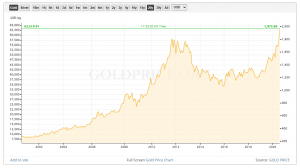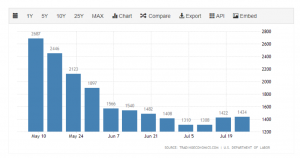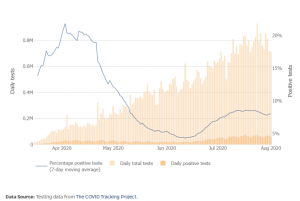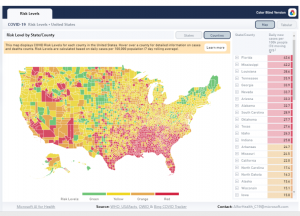The Coronavirus pandemic has created a wave of bankruptcies
As we close out another month combatting the novel coronavirus, the story varies across the country. Some parts of the country have from the beginning avoided significant outbreaks of the virus (e.g. Vermont). Others struggled mightily at the start (e.g. New York), but managed to corral the virus and appear to be well into recovery. Still others relaxed containment measures too soon and now find themselves losing the battle (e.g. Florida).
In general, the rate of infection appears to be stabilizing at an elevated level. If we cannot bend the curve down, it will be difficult for the economy to full reopen and it will be risky to send kids back into classrooms in the fall.
Mortgage Rates at Record Lows – Should You Refinance?
As you probably realize, mortgage rates are at all-time lows. The 30-year mortgage dropped below 3% recently.
Is it time to refinance your mortgage? What about consolidating debts? Do the low rates make a reverse mortgage more attractive?
Join us for our next webinar on Thursday, August 20 at 4:00 pm. Our guest will be mortgage professional Evan Swanson, CFP® of Swanson Home Loans and Cherry Creek Mortgage. We have partnered with Evan to serve our clients for many years.
Our conversation with Evan will be about 20 minutes, followed by time for you to ask Evan questions you may have. Please look for an invitation to the webinar this week.
The Economy
The big story last week was the Commerce Department’s report last week that the US economy contracted by 9.5% in the second quarter, or 32.9% seasonally- and inflation-adjusted. This the most severe reduction in economic output since records began in 1947.
A decline in consumer spending of 34.6% drove the contraction. In comparison, spending fell by 5% in the first quarter. Consumer spending makes up 70% of economic activity. So, investors will be watching it carefully, as the ranks of the unemployed grow and enhanced jobless benefits officially ended July 31.
The Federal Reserve
Chairman Jay Powell has been visible and vocal during the pandemic. Last week he urged Congress to continue to provide support to the economy. He also called on government officials to take appropriate measures to slow the spread of the virus. He noted the uneven public health response has led to an increasing infection rate and warned of a deeper downturn and slower recovery if the country is not more effective in containing the virus. Powell said, “The path of the economy will depend significantly on the course of the virus.”
For its part, the Federal Reserve announced that it would extend for an additional three months the emergency lending programs (there are nine of them) that were rolled out in the early stages of the pandemic.
COVID-19 Numbers
Globally, there have been over 18 million confirmed cases and over 690,000 deaths. In the US, over 4.6 million have been infected and over 154,000 have died.
This graph from Johns Hopkins continues to tell the story.
If you would like to see a more localized view, Harvard Global Health Institute built the heat map below:
The Markets
On Friday, the Dow Jones Industrial Average was up 115 points, or 0.44%. The S&P 500 index rose 25 points, or 0.77%. The Nasdaq increased 157 points, or 1.49%. The Dow was up 1.66% and the S&P 500 index was up 4.0% or the month of July. For the year, the Dow is off 7.72% and the S&P 500 index is up 0.83%.
The yield on the 10-year Treasury Note was down to 0.538% on Friday. Yields continue to fall as investors move funds into the safest haven, US government securities.
Spot gold, which traded at $1,581 (per ounce) at the beginning of the year, was trading at $1,991 on Friday. Gold is up 27% this year and has reached an all-time record. Here’s a 20-year graph of the price of gold.

We rarely talk about gold and other commodities, as we don’t include them in our clients’ portfolios. However, the behavior of gold this year is a clear indication that investors remain very nervous despite the dramatic recovery of the stock market.
The Labor Market
The Labor Department reported that another 1.43 million Americans filed for unemployment benefits in the week ending July 25. This marks 19 straight weeks of claims in excess of 1 million and the second straight week of increases, a foreboding indication that the economy is still very fragile. The total since March 21 is 54.1 million. There are 17 million people collecting jobless benefits, as of the week ending July 18.

Congress Deadlocked Over Additional Relief
As we have reported for several weeks now, the House, the Senate and the Administration have not come to an agreement to provide additional support for individuals, families and businesses.
The House passed the Health and Economic Recovery Omnibus Emergency Solutions Act, or HEROES Act, weeks ago. The bill includes $3 trillion in additional spending to counter the impact of the virus.
However, the Senate has expressed great reluctance to pass companion legislation. Leaders from the House, the Senate and the White House are negotiating as this is written. The list of issues is long:
Enhanced unemployment benefits. These $600 weekly payments ended last Friday. They have been a lifeline to over 30 million Americans. However, many who received these benefits had more income than they did before they became unemployed. The Senate is pushing for modifications in an extension of these benefits. Specifically, the Senate wants the amount of a flat benefit reduced and it would prefer the benefit to linked to recipients’ pre-virus wages. However, it is rather evident that states are unable to process anything other than the simplest of programs.
Stimulus Checks. Congress provided direct cash payments of $1,200 to most Americans at the start of the crisis. It appears that there is agreement to send an additional payment.
The Paycheck Protection Program. This a loan program administered by the Small Business Administration that is designed to help businesses retain workers during the pandemic. It has been a success. There have been 4.9 million loans, totaling $518 billion. We can expect Congress to extend the program, add funds to it and tighten requirements for eligibility.
Schools. The debate about opening schools has been intense. Children need to be in school. However, school must be safe for students, teachers and staff. The government will need to provide much more financial assistance to schools and universities as they attempt to open again. The money will be needed for testing, cleaning and additional staff.
Liability protection. The Senate is pushing hard for liability protection for employers, schools and universities, health care providers and nonprofit organizations. The issue is lawsuits by those who become infected with the virus at work or school and by those who claim a loved one didn’t receive proper care. We are already beginning to see these lawsuits. The House is pushing for additional protection for workers, particularly those on the front lines of the pandemic.
State assistance. The federal government will need to provide financial support to states, counties and municipalities that have been hit hard by the virus. They are spending to support businesses and citizens and their tax revenue has dropped significantly. The Senate has shown little interest in providing this support and some in the Senate have suggested that states be allowed to go bankrupt.
Testing. Congress will likely provide additional funds to increase testing, expand contact tracing, and accelerate vaccine research. However, while testing is still inadequate, it is not clear that any near-term funding will be provided for enhanced testing
Evictions. As rent abatement and mortgage forbearance programs come to an end, there is growing concern about millions of Americans losing their homes. Congress will need to find a way to balance providing strapped renters and homeowners with aid and protecting landlords and mortgage holders.
Vaccines
The greatest race in human history is well underway – to develop a vaccine for COVID-19. It is similar to the race to space. However, there are more players (national laboratories, pharmaceutical companies, research universities), more money (government, private equity, philanthropic), and more at stake (the health of every person on the planet).
The World Health Organization reported that there are 20 vaccines currently in human testing trials. Several are in large, final-stage trials, from companies including Moderna, Pfizer and BioNTech SE.
The US government will pay partners Pfizer and BioNTech SE, partner AstraZeneca PLC and the University of Oxford, and Novavax $1 billion each to secure 100 million doses of their vaccine, if/when regulators approve it. It will pay $2.1 billion to Sanofi SA and GlaxoSmithKline PC to fund the development of a vaccine and guarantee the supply of 100 million doses.
Dr. Anthony Fauci, director of the National Institute of Allergy and Infectious Diseases, said last week that he remains optimistic that a vaccine could be ready for distribution by the end of the year and in distribution early in 2021.
Parting Thought
We hope you are enjoying summer wherever you are. Certainly, this summer is unlike any other we have experienced, because of the COVID-19 pandemic, the dramatic, forced change in our social behavior, the severe recession and the social unrest related to racial injustice.
Despite these struggles, we encourage you to get outside and experience the natural world. Hike in the mountains, comb the beach, wander the parks. Breath in deeply and know that we will get to the other side of this.
Keep the faith, be safe and stay healthy.
PLEASE SEE important disclosure information at www.springwaterwealth.com/blog-disclosure/.

